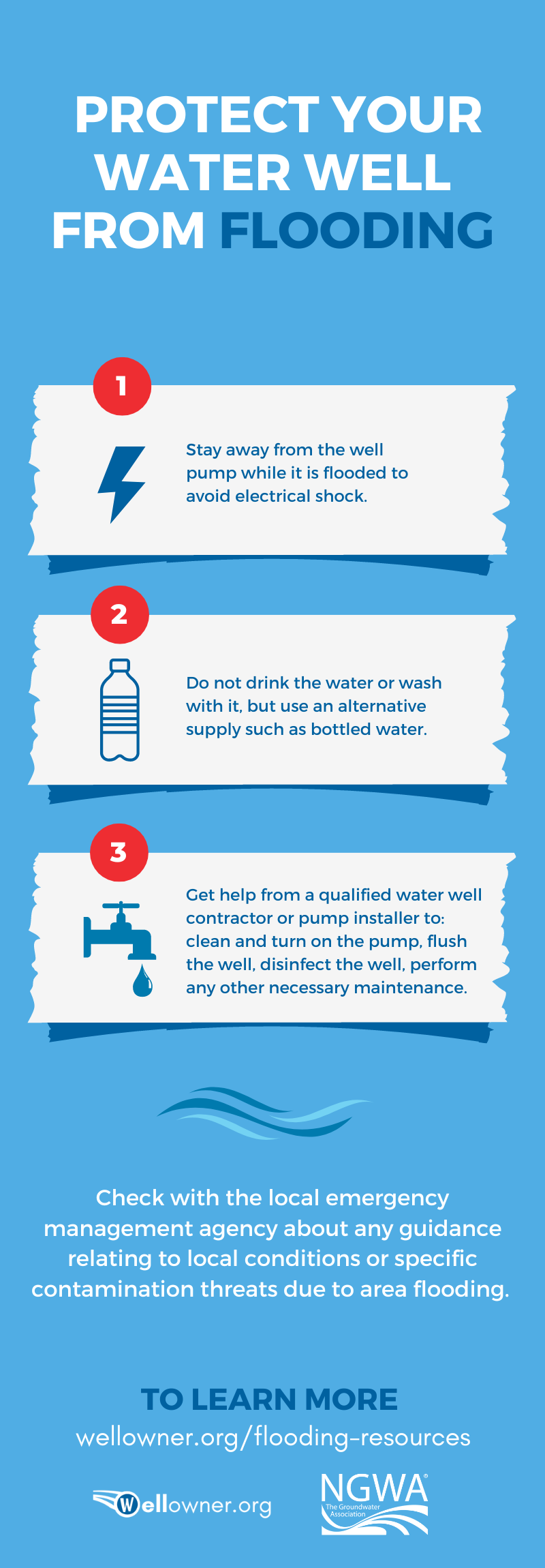As Michael Schnieders, PG, PH-GW, noted in his September 2014 Water Well Journal article wells that are susceptible to flooding or potential contamination include:
- Older wells completed in areas now designated as floodplains
- Wells in which the casing is not finished above the high-water level
- Wells not adequately capped or sealed, or older wells with shallow grout or insufficient surface seal
- Wells in areas structurally unstable, or where previous erosion or subsidence has compromised the structure and landform
- Wells with an abnormal affinity for bad luck.
Any well that has been flooded or is suspected of having been influenced by floodwaters should be viewed as unsafe for potable use until such time the well has been evaluated and tested to make sure it is safe for use as drinking water.
After a flood, the owners of household wells should take certain precautions to make sure their water is safe and their well is in good operating condition. An obvious concern is that flood water loaded with bacteria, chemicals or other pollutants may have gotten into the well. A less obvious concern is electrical shock if a non-submersible pump or any part of the well electrical system is flooded.
After a flood one should:
- Stay away from the well pump while it is flooded to avoid electrical shock
- Do not drink the water from the well or use it for washing to avoid becoming sick
- Get help from a qualified water well contractor or pump installer to:
- Clean and turn on the pump
- Flush the well
- Disinfect the well
- Perform any other necessary maintenance.
Water wells are specialized systems that require knowledge and expertise to repair and disinfect. If your well has been flooded, and you are uncertain of the electrical safety of the well, use bottled water or boil your water until a qualified water well system contractor can check out your well system. If the electrical system and controls were not flooded and operational, do what you can to pump out the well until clear. Well owners also can benefit from reading the well maintenance and water quality sections of this Web site.
Bacterial contamination is common following a flood, so disinfection and wellhead repair is important to ensure safe drinking water. Well relocation and elevation may be other options for wells impacted by rising water levels. NGWA recommends taking the following steps before and after flooding to protect your wells:
- Do not drink the water or wash with it, instead, use an alternative supply such as bottled water
- Stay away from the well pump while it’s flooded to avoid electrical shock
- Get a qualified water well contractor or pump installer to :
- Clean and turn on the pump
- Flush the well
- Disinfect the well
- Perform any necessary maintenance
- Check with the local emergency management agency about any guidance relating to local conditions or specific contamination threats due to area flooding.
March 22, 2019 — Michael Schnieders, PG, PH-GW, president and principal hydrogeologist at Water Systems Engineering Inc. in Ottawa, Kansas, discussed flooding impact on wells and aquifers in the following video interview with RFDTV.
- Well owners can search for NGWA-member or NGWA-certified professionals under “Finding a Contractor.”
- Here is a 10-minute YouTube video on water well flooding
- Other resources for well owners in flood situations can be found in the “Water Quality” section of WellOwner.org
- NGWA also has an online resources page for both well owners and water well system professionals to aid them in recovery following a flooding event. While the page focuses on flooding due to hurricanes, the information is relevant throughout in any flooding situation.



